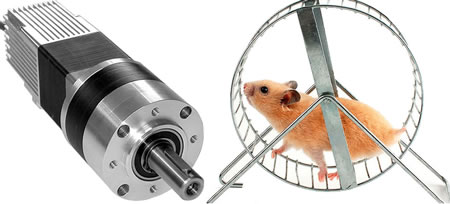The Brushless DC Motor vs. a Hamster on a Wheel

Which is a better source of generating energy: a Brushless DC (BLDC) motor or a hamster on an exercise wheel? A brief analysis follows.
Hamster Specifications
If a hamster with a mass of 100 grams were to run for two hours a day on a wheel with a radius of 10 centimeters, it would generate 0.1 Nm of torque. Considering the hamster to be in its prime and in robust condition, it may run the wheel at one revolution per second. This equates to 7,200 revolutions over the estimated two hours. (Some of these numbers are estimates for ease of calculation.) This equates to power production at 0.63 watts. Extensive trials with hamsters on wheels have not yet been done to accumulate sufficient results. However, preliminary investigations have yielded the following conclusions.
Considerations for Using Hamsters
– Hamsters need a constant supply of those tiny pellets and water, plus there are waste issues to consider.
– Operational life expectancy: the life expectancy for a hamster is roughly three years. This does not take into account considerations of diminishing returns as the hamster ages, runs the wheel less and more slowly, i.e., generates less energy, less consistently.
– Practicality of widespread use: Rodent harnesses and interfaces to transfer the generated energy into the necessary device are still in the experimental and developmental stage.
Findings Regarding Hamsters
Unreliability of hamsters on wheels makes steady energy output problematic to power office equipment, such as fax, copier and printer machines; projection equipment; phone and PBX boards; personal and desktop computers, all of which are perfect applications for the BLDC.
Brushless DC Motor Specifications
A brushless motor with a mass of 15 grams is able to produce continuous power of 0.84 watts. Rated speed: 3,600 rpm (continuous). The BLDC motor runs on electricity, which is more easily obtained than the little pellets.
Considerations for Using BLDC
– BLDC motors run on electricity, available plentifully and inexpensively.
– BLDC motors do not have brushes. This means there are fewer moving parts.
– Fewer moving parts ensures that motors are more reliable and have life expectancies of over 10,000 hours.
– Fewer instances of replacement or repair and less overall down time for projects.
Comparison of Responsiveness & Quick Acceleration
– Inner-rotor Brushless DC motors have low rotor inertia, allowing them to accelerate, decelerate, and reverse direction quickly.
– It is difficult for the hamster to turn around in the wheel.
Conclusion Regarding Hamsters vs. BLDC
While utilizing a hamster on a wheel may certainly be a unique way of generating energy to power small components in the office and home, extensive inconsistencies and uncertainties, not to mention illegalities, make the election of the Brushless DC motor a much more viable and reliable alternative.